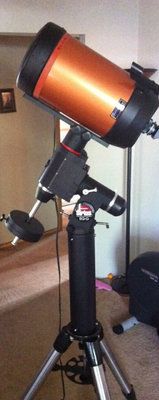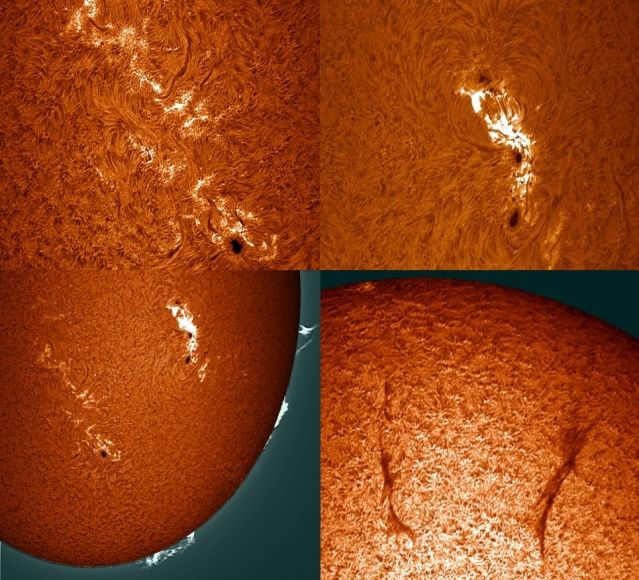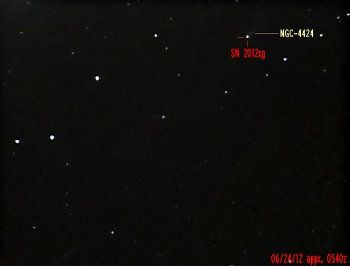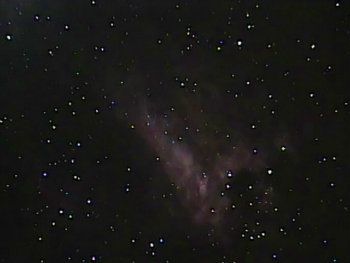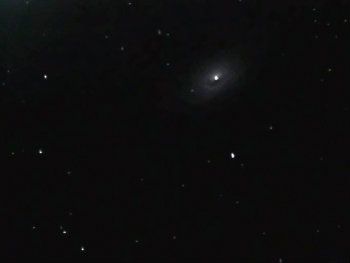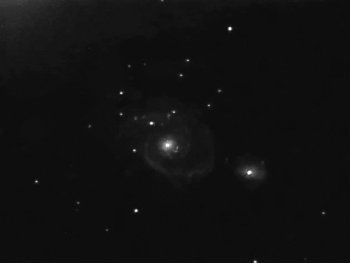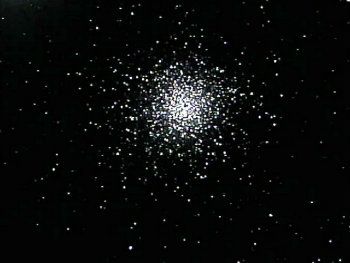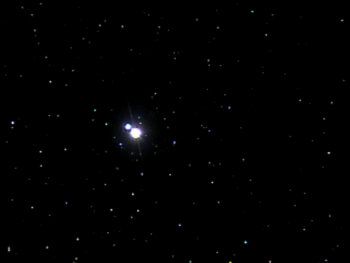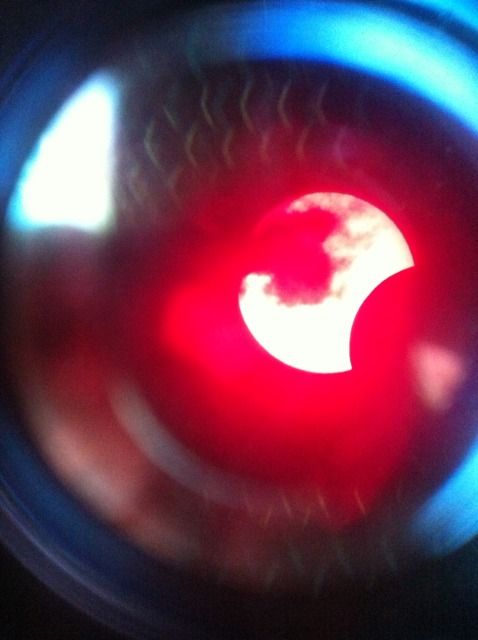Well my friends it has been a long time since I updated my blog. An update to the current state of my scope and mount is that I believe I have pushed past the AP load limit on my mount. With the ST80 and SSAG and mounting gear, my scope is pushing around 19 pounds. The stock counterweight bar on the Sirius EQ-G isn't long enough to properly balance with 2 11lb counterweights, so I need to look into a counterweight bar extension from scopestuff. I tried sandwiching a 2lb weight between the 11lb weights, but there is too much slop and it makes balancing the mount difficult. I am kindof at a standstill until I can extend the counterweight bar, or I will have to dump the ST80/SSAG setup. Hoping I can upgrade to an Atlas this tax season.
Another reason for infrequent updates is work has been keeping my highly busy and highly stressed. 12-14 hour days are not uncommon and at the end of the day I just don't have the energy to lug all the gear outside and orchestrate everything to play nice with each other and work properly. I regret it too, as Jupiter is in prime position for imaging and I have let way too many good evening slip by as I was simply too exhausted. I hate my job for this very reason.
The real reason for this update is to let everyone know that I am back again in the h-alpha club. I have purchased a used Coronado PST from a gentleman and it should be here this week. A lot of folks have commented that I will be disappointed with the PST based on my previous experience with the Lunt LS60tha. During a solar outreach earlier this year, I had an opportunity to look through a fellow OKCAC member's PST. With mine setup close by, I was able to get a good handle on the difference in visual performance between the two scopes. I can honestly say that the PST was a very good performer, and that the difference was only slightly in favor of the Lunt 60. I remember thinking to myself that the negligible difference in view certainly did not constitute almost 500.00 dollars in price difference. So while I know that the Lunt I had just barely beat the PST in visual performance, I think the PST will satisfy my solar observing needs for a long time. My only fear is that PST performance can vary from scope to scope, and I hope I get a good one compared to the one I got to use last summer.
Another challenge to overcome before doing any serious imaging is that I have sold off all of my solar gear associated with the Lunt. I will need to purchase or cannibalize another tracking mount and I should probably be looking at another monochrome imager such as the DMK21. I do have a DBK21AU4 that I can use, but due to the restrictions of imaging h-alpha, a monochrome imager is ideal for using full resolution. I really cant wait to look at the sun again, it has been way too long.
Updates to follow more frequently I hope.
Sunday, December 30, 2012
Sunday, September 16, 2012
Scope Upgrades
Sold the CG-5asgt and my other 8" deforked SCT. Used the proceeds to prep my scope for the Orion Awesome Autoguider Package (which will be here next Tuesday). I upgraded the finder to the ubiquitous Telrad, and added the signature orange Celestron losmandy D dovetail rail. I also purchased 2 astrotech losmandy-d rail adapters that I am going to mount the guidescope rings on. There were several reasons why I decided to use this configuration. The vixen style rail that comes with the Orion package is too long for my OTA, so either I cut it and paint the end or leave it on and let it overhang. Either way would look ugly. Also, as the kit comes, it will not be able to be mounted to the OTA. I would have had to buy radius blocks from ADM to give the bar the clearance necessary to mount the rings. Again, expensive and would look hideous. The combination of the celestron bar and astrotech adaptors was around 90 dollars, not much more than just a pair of radius blocks from ADM. I am very happy with this setup and wish the SSAG package was here to install.
Only bad thing? The extra weight has thrown my scope far out of balance. I cannot use my scope again until I order another 11' counterweight. Bummer. Will have to be next paycheck.
Only bad thing? The extra weight has thrown my scope far out of balance. I cannot use my scope again until I order another 11' counterweight. Bummer. Will have to be next paycheck.
Sunday, September 2, 2012
Holiday weekend fun
So I sit here downing a Coors light and putting the finishing touches on the hand controller box for my DIY motorized focuser. I had posted a link a long time ago but tabled the project. After imaging Jupiter the other night with the DBK camera, I decided a motorized focuser was not a luxury item, but rather was an essential needed device. I still think that my final images were a little soft on the focus, so hopefully this will remedy that. Looking at the JMI MotoFocus designs, I figured that the price was just too prohibitive, and since I am always on a low budget, decided to go the DIY route explained in the following two links:
http://emediadesigns.com/emediadesigns.com/focuser/
http://www.cloudynights.com/ubbthreads/showflat.php?Cat=&Board=nexstar&Number=5038166&Forum=,,,,f36,,,,&Words=focuser&Searchpage=4&Limit=25&Main=5038166&Search=true&where=sub&Name=&daterange=1&newerval=&newertype=w&olderval=1&oldertype=w&bodyprev=#Post5038166
I had a bunch of various parts laying around so I decided to tackle the hand controller, which I am glad to report is complete. It really was pretty easy, but as I found out earlier soldering is a frangible skill. After scalding the hell out of my thumb on the iron, I decided I need to do it more often (incident occurred pre Coors light BTW). Only deviation from the above mentioned plans is that I decided to mount the battery container on the outside of the box so that I would not have to unscrew the cover plate if I needed to change the batteries. Being clumsy I also decided to make the box bigger so that I could manipulate the controls easier in the dark. I am pretty happy with the results, now all I have to do is cannibalize a phone or ethernet cable and attach some mono plugs. I then need to obtain a servo and cut the stops out of it so it will work in full rotation. Fashion a mounting bracket to connect to scope and I will be in business at a quarter of the cost of the JMI unit.
http://emediadesigns.com/emediadesigns.com/focuser/
http://www.cloudynights.com/ubbthreads/showflat.php?Cat=&Board=nexstar&Number=5038166&Forum=,,,,f36,,,,&Words=focuser&Searchpage=4&Limit=25&Main=5038166&Search=true&where=sub&Name=&daterange=1&newerval=&newertype=w&olderval=1&oldertype=w&bodyprev=#Post5038166
I had a bunch of various parts laying around so I decided to tackle the hand controller, which I am glad to report is complete. It really was pretty easy, but as I found out earlier soldering is a frangible skill. After scalding the hell out of my thumb on the iron, I decided I need to do it more often (incident occurred pre Coors light BTW). Only deviation from the above mentioned plans is that I decided to mount the battery container on the outside of the box so that I would not have to unscrew the cover plate if I needed to change the batteries. Being clumsy I also decided to make the box bigger so that I could manipulate the controls easier in the dark. I am pretty happy with the results, now all I have to do is cannibalize a phone or ethernet cable and attach some mono plugs. I then need to obtain a servo and cut the stops out of it so it will work in full rotation. Fashion a mounting bracket to connect to scope and I will be in business at a quarter of the cost of the JMI unit.
I will post updates as I complete the project.
Saturday, September 1, 2012
First Jupiter of season
Got the Baader UV/IR cut filter in the other day, but work and weather kept me from getting a decent shot at some imaging. Broke that streak last night, and here is the best of the lot. I decided to simply use my OTA on it's original NexStar mount and found out quickly just how much worse an altaz mount is at accurate tracking with high magnifications. Always had to chase it around last night, I guess I got spoiled with the EQ mounts. I should have used my Sirius mount last night, but I wanted quick setup and tear down. At any rate, .avi sequences averaged around 600+ frames at the 90 second mark. Stack, alignment, RGB alignment, and wavelet processing all done in Registax V6. Scope is C8, camera is original DBK-21.
Focus seemed a little soft. I am working on a DIY Bahtinov mask for fine focus. Couple things were evident as critical for my shopping list last night, though. A 3x barlow and motorized focuser are a must. Flip mirror and illuminated crosshair eyepiece parfocal on the mirror would be REALLY nice as well. Time to start pinching pennies.
Sunday, August 12, 2012
DBK-21 first light
Last night I was hoping to try out the new DBK-21 cam on Jupiter and maybe catch some Perseid meteor shower action as well. I setup right before dark, and perhaps a little too hastily. GOTO performance was not very good, worked well at first but had some issues later in the evening. Some were good, others well not so much. I attribute that to targets being on the meridian. not too familiar with how this affects EQ observing, but it seemed to have an effect last night. At any rate, I setup and in my boredom, decided to try to image Uranus. I knew not to expect any detail, so believe it or not I am actually happy with the following image of the little blue dot. Imaged at 0542ut, this is a process of 50 frames, stacked, aligned, and RGB alignment in registax v6. C8 on Sirius EQ-G. No barlow. DBK-21 camera from Imaging Source.
Uranus, 0542ut C8/DBK21
I continued to play around with different targets, suffering some way off GOTO performance. Still not sure what all that was about, but I did not pay proper diligence to my normal setup. Was pretty rushed with it.
I was pretty stoked to see Jupiter rise above my eastern obstructions around 0245 local. I had started to dial in the settings on the camera when a cloud bank rolled in. I didn't even get to capture one .avi sequence. One thing was pretty apparent is that the uv/ir cut filter required for this camera is extremely critical on Jupiter. Color was obviously skewed, but there was a hazy halo around the entire planet that was very distracting. I am assuming that was IR light washing out the edges. I will have to order a good uv/ir blocking filter. I will try again next week though. Somewhat pissed that I had waited so long for Jupiter and the height of the Perseid meteor shower only to be clouded out, I decided to pack it in. To add insult to injury, it started raining so I had to do a very fast breakdown. No harm done, but hopefully next week I will have better results to post up.
Sunday, July 29, 2012
EQMOD Scope control demo from tonight 7/28
Saturday, July 28, 2012
Lots of changes
Last week I traded my beloved Lunt 60 solar scope. I loved that little scope, but I decided to trade for a mount more suitable for AP work. After we cycle down from the solar maximum, I will pick up a used PST to satisfy my urge for solar imaging. I ended up trading for an Orion Sirius EQ-G (little brother to Atlas mount) with a deforked fastar-compatible C8 with starbright coatings. Also included was the Celestron pelican case and cases for everything else. I got tons of accessories and netbook to control the mount/scope via EQMOD/EQASCOM. The mount itself is only 7 months old and used a handful of times.
I swapped out the tripod (1.75"OD legs) with the sturdier tripod (2.0"OD legs) from the CG-5 asgt mount. I ordered and installed the Orion 16" SVP Pier extension, which is compatible with both tripods. After learning how to polar align the cg-5, I decided I wasn't going to crawl on the ground anymore. I must admit, with the scope and mount attached to the pier extension, it is quite a formidable setup.
I swapped out the tripod (1.75"OD legs) with the sturdier tripod (2.0"OD legs) from the CG-5 asgt mount. I ordered and installed the Orion 16" SVP Pier extension, which is compatible with both tripods. After learning how to polar align the cg-5, I decided I wasn't going to crawl on the ground anymore. I must admit, with the scope and mount attached to the pier extension, it is quite a formidable setup.
Another shot of the "Twins":
I put the trade scope on the CG-5 ASGT mount and plan to use for visual use or planetary imaging while I do my DSO subs with the NS8SE OTA on the Sirius mount.
About the Sirius mount. There sure isn't as much review information on the internet as it's big brother, the atlas. The motors and controls are the same, however the payload limit of this system is rated at 30lbs. I figure my OTA with eventual guidescope package and imager will place it between 16-18 lbs depending on the imager used. A little over half of the visual rating, it means I will have to give extra attention to balancing if I plan to be successful with AP. I am also thinking real seriously about going the hyperstar route next year at tax time.
The motors on the Sirius mount are amazingly quiet when compared to my CG-5. The CG-5 is pretty loud, and although it never really bothered me before, compared to the Sirius I can see where they can get annoying. The mount was purchased originally without a hand controller, so I connect to the mount using EQMOD/EQASCOM and sync goto's with Cartes du Ciel. I really didn't like CdC at first, being familiar with stellarium and all, but I have to admit that it has grown on me. Uncle Rod pointed me in the right direction to get it setup in a similar fashion to stellarium.
About EQMOD. This program is simply amazing, giving me much more control and trouble-free operation than NexRemote ever could. It is a bit of informational overload, due to the never-ending list of features. The trick is to take several nights and take small bites, rather than try to chew on it all at once. I took several nights learning different features and over the course of last week, I feel pretty confident in using it. I downloaded the voicepack and installed it so now the mount talks to me when operating. Audible alerts and announcements are completely customizable, allowing any sound or .wav to be assigned to nearly every aspect of mount/scope operation. I am currently compiling some star trek computer sounds to plug in, because yes, I am that big of a nerd. I will say this about EQMOD, it is light-years ahead of NexRemote.
So my plans are, for the moment...to sell the Nexstar 8 altaz mount (350 with manual, nexremote software, HC extender, HC, computer/hand control cable, no power cord) and purchase an Orion SSAG package. I also plan on selling my DMK21 monochrome imager (300) and purchasing the color equivalent DFK/DBK21 for planetary imaging (since only needed monochrome for h-alpha imaging).
Tonight will be first light with this new setup. Hoping for clear skies and good luck!
Wednesday, July 4, 2012
Sunday, July 1, 2012
Solar Goodness and First Light with CG-5 ASGT
Yesterday turned out to be a really good day. I woke up and took immediate note of the swaying tree in the front yard and determined that it would probably be too windy to try for any solar imaging. As I got around, I logged online to see some amazing prominence shots on the GONG h-alpha solar monitor site. I decided to brave the wind, and I am glad that I did. Imaging yesterday gave me a stress-free day (no transit, no public outreach) to really experiment and play with the IC capture software that came with the DMK-21. As such I think I found a sweet spot on the gamma slider bar where the darker, contrasty details really pop out at you. I did some imaging, and active regions AR1515 and 1513 took the cake. I was amazed out how much detail I was able to get with the DMK and the single-stack Lunt 60tha.
After processing the above images, I became keenly aware that it was saturday evening and I was very bored, and very broke. I decided to give my Celestron CG-5 ASGT mount a try. I didn't really have the energy for a full blown imaging session, and I believe the moon was at 91 percent illumination anyway. Honestly I just didn't have the energy to drag out all the apparatus necessary. I decided to make it a visual session only, that would give me time to figure out polar alignment. You see, I have read many a manual and tutorial, but have never actually done a polar alignment routine. I dragged the behemoth out side, set the correct leg to North, and began the procedure just as soon as I could see Polaris. Turns out, alignment was a snap with the polar scope. What I didn't like though, was that in order to get the optics perfectly aligned, I had to fudge a little from the index marks. I will look into this more, I was kinda flying by the seat of my pants. After everything was aligned, I went to work. One thing that I will say is that it sure was different to align a GEM mount than the alt-az. I like being able to choose which stars I align to, my choice this time of year being Vega and Spica. The mount forced me to choose between western stars, then I could add eastern calibration stars. Not to bad, just different. I chose Spica and Alkaid, then added Vega as a calibration star and I was off to the races. First target: Albiero. Next target: M57. All of my gotos were off, but I attribute this to a.) index mark change in home position during initial startup (error due to my inexperience) and b.) pitiful power cord and partially charged battery. I did have a runaway goto indicative of a low voltage problem, but as mentioned above, the power cord is the weak link here and I have observed about 5 sessions on my power tank, so I know it has to be about done. I mean, the gotos were not that bad off, just usually slightly out of the FOV on the top of the eyepiece.
Other impressions? This mount seems rock solid. Some old salts will probably laugh at that statement, as one of the chief complaints of the mount is that it isn't very solid. My experience coming from the NexStar 8SE with it's overworked mount and 1.50" skinny tripod legs. The ASGT with the 2" tripod legs makes a huge difference. Vibrations dampened quickly, and I was actually able to focus manually with out using four-letter words and waiting on the vibrations to settle down. If this mount seems rock solid, I cannot wait to see what the Orion Atlas is like.
To sum up, I was very pleased with the first performance of this mount. Tracking seemed dead-on, nothing appeared to travel in the eyepiece (true test will be photography). Setup is a bit more involved, but really only slightly so. My problems with gotos are probably user error or power deficiency. I can live with that.
Sunday, June 24, 2012
Amazing night part 2: Moon/Saturn
Although seeing was not the best, I still managed some decent shots of the moon and a so-so shot of Saturn. These are with the imaging source DMK-21. Some of them seem a little over-sharpened. It is hard not to play Horatio from CSI with registax, "Enhance......enhance.....enhance" Enjoy!
Amazing night part 1: Deep sky
Last night was one of those rare nights when everything worked perfectly together to create a very memorable night. Weather was nice, mediocre seeing limited magnification, but no wind, nice temps, and no dew! My goal for the night was to bag supernova SN2012cg in NGC 4424 in the constellation Virgo. I had tried earlier in the week when I read Rod Mollise's facebook post and saw his picture. He has a Mallincam Xtreme and bagged it with his C8 and a 14 second exposure. I thought since I had a c8 and my Mallincam has a 14 second limit, I should be able to get it. Wind, time, and bad alignment made sure that it didn't happen earlier in the week. I vowed to try again on saturday evening, and did so. Got lucky this time. With the success of imaging the supernova, I decided to try my hand at some other deep sky targets that I had never tried. Here are the results...
Swan Nebula:
m64:
m51:
m13:
Albiero:
Saturday, June 16, 2012
Celestron ASGT CG-5 equatorial mount, got it working!
I had the good fortune of picking up a used Celestron CG-5 advanced/goto series mount from a fellow member of OKCAC. He said that everything worked, it just had a cosmetic issue, the declination motor housing was cracked and held together with tape. I pulled the trigger on it, as it was an amazing good deal at fraction of the price of new.
After unloading my truck, I setup the CG-5 mount in the living room. There were some other issues, but for the money it was a bargain. I was a little scared though, as I went to power up the mount, there was nothing. After doing some research online, it looked like the mount fell victim to the number one failure of these mounts: the power switch. I took out the power board and clipped a jumper to bypass the switch. It fired right up. I then soldered a permanent jumper bypass, so now I use the power switch on my power tank to turn the mount on and off. Couple of issues, I spent 72 bucks with celestron ordering parts. I ordered a new set of latitude adjustment screws, as the originals were missing. I ordered a new declination motor assembly housing and a new counterweight bar. After permanently soldering a jumper on the power board, I reassembled and fired it up. I did a test/fake alignment and it worked like a charm. Motors work smoothly on both axis and I test fitted my scope. I balanced the OTA per instructions and with the RA/DEC levers loose the scope moves freely and smoothly. I am very happy that I have this mount working like new. Here is a picture of the NS8SE scope on it's new home. Please excuse messy office.
After unloading my truck, I setup the CG-5 mount in the living room. There were some other issues, but for the money it was a bargain. I was a little scared though, as I went to power up the mount, there was nothing. After doing some research online, it looked like the mount fell victim to the number one failure of these mounts: the power switch. I took out the power board and clipped a jumper to bypass the switch. It fired right up. I then soldered a permanent jumper bypass, so now I use the power switch on my power tank to turn the mount on and off. Couple of issues, I spent 72 bucks with celestron ordering parts. I ordered a new set of latitude adjustment screws, as the originals were missing. I ordered a new declination motor assembly housing and a new counterweight bar. After permanently soldering a jumper on the power board, I reassembled and fired it up. I did a test/fake alignment and it worked like a charm. Motors work smoothly on both axis and I test fitted my scope. I balanced the OTA per instructions and with the RA/DEC levers loose the scope moves freely and smoothly. I am very happy that I have this mount working like new. Here is a picture of the NS8SE scope on it's new home. Please excuse messy office.
Tuesday, June 12, 2012
Some photos from saturday's informal star party
OKCAC member Bill Wilburn posted some really amazing long exposure photos from the informal star party the other night at Lake Hefner. Reposted with permission. These are really amazing! Thanks for posting these!
Sunday, June 10, 2012
Informal Outreach at Windsurfer Point
Thursday, June 7, 2012
Venus transit, OKCAC watch party at SMO
Well the big day finally came and I managed to get off work at noon. I got home, grabbed a quick bite and loaded up the truck. I arrived at the Science Museum Oklahoma parking lot at approximately 1530 to setup. I saw Mike and Wayne and we chatted a bit while I set up my gear. I was not prepared for the large crowd that gathered, at one time reaching about 200 at once. It was quite an ordeal, and it was estimated that attendance through the event was in the neighborhood of 500+. It was an amazing time! Seeing the wonder on guests faces was totally worth it. At any rate, I was able to get some of the video sequences processed to post some shots. From first contact, the weather held about 45 minutes before a cloud anvil put an end to clear viewing. Some of these shots were overexposed due to trying to beat the clouds. DMK21 performed beautifully.
Saturday, June 2, 2012
Little Blue Wonder, AKA the Imaging Source DMK-21
Well my friends, I finally bit the bullet and purchased what many imagers consider to be a "real camera" for solar, lunar, and planetary work. I got the USB2 version of the popular DMK-21 camera from Imaging Source. I initially wanted (and still do) the DMK-41 with the larger chip. An unforeseen and really maddening event sidetracked me and forced me to trim my camera budget a little bit. Still kinda pissed about it, but it is as they say, crying over spilled milk.
Funny story actually, I purchased the camera from OPT, same place I bought my Lunt 60 solar scope. Their customer service is just plain amazing. I asked for a shipping quote to see if I could get the camera delivered by tuesday, in time for the transit. They quoted me 90 dollars, and I thanked them but told them that it was a bit over my budget. I got a call back from Craig about a half hour later and was advised that they could overnight it at just at 60 dollars. I said "Deal!". Great folks over there.
Back to the imager. I have been wanting a monochrome imager for several months now. It is almost essential in imaging the sun in hydrogen alpha light. You see, in a regular color camera, there is an RGB microlens installed over every pixel in what is known as a Bayer configuration. Red and blue make up 25 percent coverage each, with green making up the other 50 percent. Since the bandwidth of h-alpha light is so narrow (.7 angstrom on my scope) and it resides in the red spectrum, only 25 percent of the resolution on the imager is being utilized. With a monochrome imager, I am now able to truly image in full resolution. Due to the size of the chip, the image is constrained to 640x480. I was worried that this would be far too narrow for large surface area targets such as the moon and sun. As it turns out, it isn't so bad. If I am careful and observant, I think I can get a full disk shot of the sun in a 4 panel mosaic. If not, definitely a 6 panel shot. I guess I will be learning how to stitch mosaics together. With the Tucsen imager, I was able to get the full disk on chip, but just barely. To be honest, I don't mind stitching mosaic panels together because the quality is so much better anyway.
I also plan on doing lots of lunar and planetary work with this sweet camera. I will need to save my money for an LRGB filter set and a filter wheel so that I can get true color razor sharp shots. Until this I will be doing lots of practice in monochrome. The capture software that comes bundled with DMK-21 is amazing. Everything to control the parameters of the shot as well as capture can be added to a set of toolbars for quick and easy reference and use. It is pretty rock solid and a huge improvement over the AMCAP software I have been using. Frame rate is lightening fast, and I usually average 45fps on my system. I did a quick session today under the sun to gauge this cam's performance and I am very very pleased. Judge for yourself. Lunt 60 single-stack/b600/ tilt-tuned solar scope and DMK-21. Close shots use an astrotech 2x barlow. Captured today between 2100-2130UT.
Funny story actually, I purchased the camera from OPT, same place I bought my Lunt 60 solar scope. Their customer service is just plain amazing. I asked for a shipping quote to see if I could get the camera delivered by tuesday, in time for the transit. They quoted me 90 dollars, and I thanked them but told them that it was a bit over my budget. I got a call back from Craig about a half hour later and was advised that they could overnight it at just at 60 dollars. I said "Deal!". Great folks over there.
Back to the imager. I have been wanting a monochrome imager for several months now. It is almost essential in imaging the sun in hydrogen alpha light. You see, in a regular color camera, there is an RGB microlens installed over every pixel in what is known as a Bayer configuration. Red and blue make up 25 percent coverage each, with green making up the other 50 percent. Since the bandwidth of h-alpha light is so narrow (.7 angstrom on my scope) and it resides in the red spectrum, only 25 percent of the resolution on the imager is being utilized. With a monochrome imager, I am now able to truly image in full resolution. Due to the size of the chip, the image is constrained to 640x480. I was worried that this would be far too narrow for large surface area targets such as the moon and sun. As it turns out, it isn't so bad. If I am careful and observant, I think I can get a full disk shot of the sun in a 4 panel mosaic. If not, definitely a 6 panel shot. I guess I will be learning how to stitch mosaics together. With the Tucsen imager, I was able to get the full disk on chip, but just barely. To be honest, I don't mind stitching mosaic panels together because the quality is so much better anyway.
I also plan on doing lots of lunar and planetary work with this sweet camera. I will need to save my money for an LRGB filter set and a filter wheel so that I can get true color razor sharp shots. Until this I will be doing lots of practice in monochrome. The capture software that comes bundled with DMK-21 is amazing. Everything to control the parameters of the shot as well as capture can be added to a set of toolbars for quick and easy reference and use. It is pretty rock solid and a huge improvement over the AMCAP software I have been using. Frame rate is lightening fast, and I usually average 45fps on my system. I did a quick session today under the sun to gauge this cam's performance and I am very very pleased. Judge for yourself. Lunt 60 single-stack/b600/ tilt-tuned solar scope and DMK-21. Close shots use an astrotech 2x barlow. Captured today between 2100-2130UT.
Sunday, May 20, 2012
Partial solar eclipse, 5/12
Well I woke up this morning and took a look at the oklahoma meso-net satellite image wondering if I would be able to see the partial solar eclipse today. I was hopeful because despite a bad forecast, some folks were predicting a clearing of central oklahoma by the time of first contact. I sat on the edge of my seat all day, and around 1805 local, I saw the first blue sky patches. My original intent was to join the fine folks at the OKCAC for their viewing at windsurfer point on lake Hefner. Due to low gas in the tank, I opted for a more local viewing area. I drove out to my local lake and parked near the water treatment plant. This location had the best view of the western horizon.
I fired up the laptop and the inverter and the inverter bit the dust. I was able to get the scope aligned and tracking thanks to a gracious 4 minute long sucker hole. With the scope tracking well off the power tank, I tried to tackle the problem of the power inverter. I plugged it in straight to my car and started it, but the inverter was toast. This was unfortunate, I was not able to do any imaging and there was not a power plug in 300 yards of me. Literally burning daylight, I opted to stay at that location and try to image afocally with the iphone camera. Not the best, but it did not let me walk away empty handed. As it turned out, the pics that I got were all I was going to get this evening. A cloud bank rolled in and blocked my solar view all the way through sunset. I was bummed, but even the crappy afocal pics were pretty surreal. Worth it? You bet!
I fired up the laptop and the inverter and the inverter bit the dust. I was able to get the scope aligned and tracking thanks to a gracious 4 minute long sucker hole. With the scope tracking well off the power tank, I tried to tackle the problem of the power inverter. I plugged it in straight to my car and started it, but the inverter was toast. This was unfortunate, I was not able to do any imaging and there was not a power plug in 300 yards of me. Literally burning daylight, I opted to stay at that location and try to image afocally with the iphone camera. Not the best, but it did not let me walk away empty handed. As it turned out, the pics that I got were all I was going to get this evening. A cloud bank rolled in and blocked my solar view all the way through sunset. I was bummed, but even the crappy afocal pics were pretty surreal. Worth it? You bet!
Subscribe to:
Posts (Atom)








